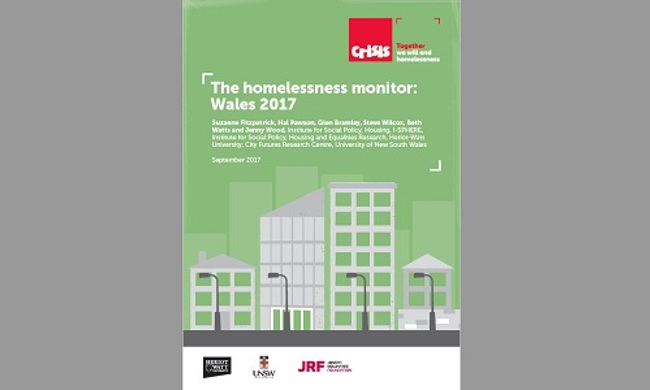The Homelessness Monitor: Wales 2017
06.09.2017
The Homelessness Monitor: Wales 2017 is the third report in Wales of an independent study, commissioned by Crisis and funded by Crisis and the Joseph Rowntree Foundation, of the homelessness impacts of recent economic and policy developments in the UK.
Key Findings
- There is an overwhelming consensus that the new statutory homelessness framework ushered in by the Housing (Wales) Act 2014 has had an array of positive impacts, including re-orientating the culture’ of local authorities towards a more preventative, person-centred and outcome-focussed approach, and engendering a much better service response to single homeless people in particular.
- In 2016/17, almost two thirds (62%) of households assessed as ‘threatened with homelessness’ (5,718 of 9,210) had had their homelessness successfully prevented, according to official statistical returns, while a 41 per cent success rate (4,500 of 10,884) was recorded by local authorities in homelessness relief cases – i.e. resolution of actual homelessness (as opposed to interventions to prevent homelessness occurring)
- As expected, and hoped, the number of priority need households assisted under the new ‘duty to secure accommodation’, activated only after prevention and/or relief efforts have failed, is much lower than statutory homeless ‘acceptance’ levels under the pre-2015 system.
- However, the gradual downward trend in temporary accommodation placements seen in the period 2012- 2015 has been recently reversed. The most recent 12-month period saw placements rising by 7 per cent. Given the expectation that a strengthened emphasis on up-front prevention under the new statutory regime would lead to reduced ‘inflow’, this is somewhat contrary to what had been anticipated, and may reflect the intensifying structural pressures and growing ‘footfall’ noted below.
- Even under this new, much more inclusive, Welsh statutory model, there is a substantial cohort of homeless applicants for whom local authority offers of assistance fail to yield a resolution to their housing crisis (though some may manage to find their own resolution). The key group here involves households judged legally homeless but whose problems are ‘unsuccessfully relieved’ and who are then deemed ‘non-priority’ cases ineligible for ‘full rehousing duty’ under Section 75. In 2016/17 this group numbered 1,233.
- There is particular concern about cases which fall out of the system specifically due to ‘non-cooperation’, given that this is a key innovation in the Welsh legislation, and has, in amended form, been taken over into the Homelessness Reduction Act 2017 in England. In 2016/17 486 of 9,210 Section 66 ‘eligible and threatened with homelessness’ cases (5%) and 615 of 10,884 Section 73 ‘eligible and homeless’ cases (6%) had duty discharged a result of ‘non-cooperation’.
- There has been an undisputed recent rise in rough sleeping in Wales, and though the precise scale of this increase is unclear, it seems likely to fall in the range of a 16 per cent to 30 per cent uplift as compared with 2015. A policy announcement from the Welsh Government on rough sleeping is imminently expected.
- Successive UK Government welfare reforms will take over £1 billion annually out of the pockets of low income households in Wales by 2020/21. They have a disproportionate impact in areas of Wales that have suffered from long term industrial decline.
- Almost all Welsh local authorities responding to our 2017 local authority survey believed that homelessness in their area had been exacerbated by post-2010 welfare reform, with the extension of the Shared Accommodation Rate of Local Housing Allowance to 25-34 year olds most commonly identified as especially damaging.
Reference
Fitzpatrick, S., Pawson, H., Bramley, G., Wilcox, S., Watts, B. & Wood, J. (2017) The Homelessness Monitor: Wales 2017. London: Crisis

